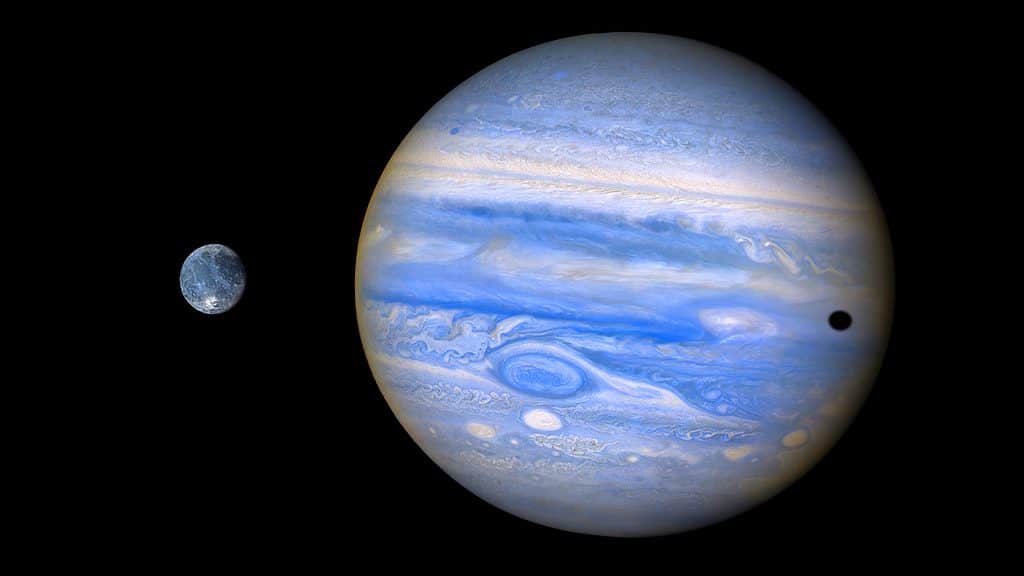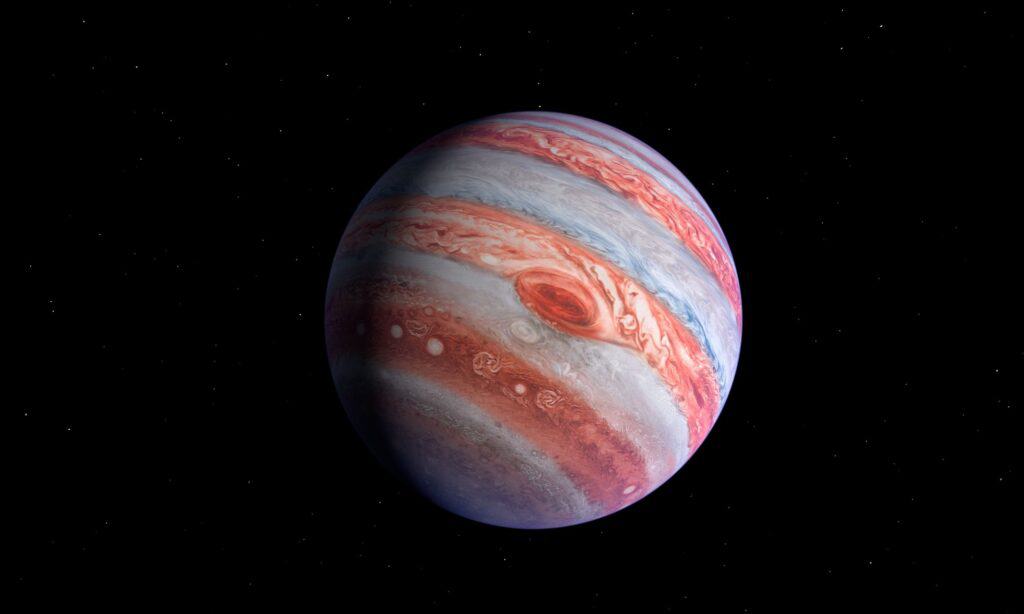Jupiter is the fifth planet of our solar system and by far the largest one of all. At over 1,300 times larger than Earth, It’s so big you can often see it from the naked eye looking like a bright star when conditions are right. With binoculars or a small telescope, you can even make out up to four of its moons. Just how large is Jupiter? In this article, we will explore the various aspects of Jupiter’s size, including its mass, surface area, and diameter. Along the way, we’ll provide you with tons of other fascinating facts about this king of all the planets.

This is a false-color composite image of Jupiter and Ganymede, the largest planet and the largest moon in our solar system.
©Claudio Caridi/Shutterstock.com
Jupiter: History and Description
Amateur and professional astronomers have known about Jupiter since ancient times. Babylonians first observed it as early as the 7th or 8th century BCE. Along with the other visible planets, ancients considered it a “wandering star” because it sometimes appears to stop and reverse direction. We now know this is because it is not a star but another planet orbiting the Sun as Earth is, but our orbits are different sizes and we are moving at different speeds. The name “Jupiter” comes from the ancient Roman king of the gods, equivalent to the Greek god Zeus.
The modern study of Jupiter really started with Galileo, who observed the planet and four of its largest moons through a telescope. Over the centuries, knowledge of the planet gradually accumulated but it took a huge leap forward with the invention of increasingly powerful modern telescopes and spacecraft such as the Pioneer, Voyager, Galileo, and Juno missions. This research has revealed a tremendous amount of data on the planet’s chemical composition, weather, and the existence of a large number of previously unknown moons and a faint, broken ring system. One of Jupiter’s most distinctive features is its “Great Red Spot,” which is now understood to be a gargantuan hurricane as big as three Earths that has windspeeds of 268 mph that and has lasted for at least 350 years!

Jupiter’s Great Red Spot is a 350-year-old storm as big as three earths!
©joshimerbin/Shutterstock.com
In 1994 comet Shoemaker Levy 9 came too close to Jupiter and broke up into two dozen fragments that slammed into the planet. The largest fragment created an explosion estimated at 48,000 megatons of TNT, which is nearly 1,000 times bigger than the Tsar Bomba, the largest nuclear weapon ever detonated. The impact left a dark circle of cometary debris in the planet’s atmosphere that was larger than the diameter of the Earth! This incredible light show underscored how Jupiter and the other outer planets help protect the inner solar system from cosmic impacts by drawing comets and asteroids with their immense gravitational pull.
Jupiter: Fascinating Facts
Here are some interesting things to know about the largest planet in the solar system:
- Jupiter’s atmosphere is made mainly of hydrogen and helium, like the sun. This is why it is sometimes called a “gas giant” planet.
- Jupiter has the shortest day of any of our planets. It takes just a few minutes less than 10 hours to rotate on its axis
- Jupiter has a faint ring system that is made mainly of dust, rather than the highly reflective ice particles as Saturn’s magnificent ring system is made of.
- Jupiter has 79 known moons, most of which were not discovered until spacecraft visited the planet up close. Its largest moons are named Io, Europa, Ganymede, and Callisto.
- Io has over 400 volcanoes and is the most volcanically active object known in the solar system.
- Ganymede is the largest moon in the solar system, so big it has its own magnetic field.
- Jupiter’s gravity is so strong, it exerts an influence on the Sun. For this reason, it does not orbit the center of the sun, but a spot near its surface.
- The average temperature of Jupiter‘s atmosphere is around -145 degrees Celsius (-234 degrees Fahrenheit).
- Jupiter’s mass is over 300 times larger than Earth’s, and it exerts a gravitational pull on the Sun itself.
- The first spacecraft to visit Jupiter was NASA’s Pioneer 10 in 1973, and the most recent is Juno, launched in 2016, and presently in orbit around the planet and will send back data at least until 2025.

Jupiter’s moon Io has over 400 volcanoes and is the most volcanically active object known in the solar system.
©Elena11/Shutterstock.com
Jupiter: Mass
Jupiter has the largest mass of any planet in the solar system – actually twice the mass of all the other planets combined! Its mass of 1.899 × 1027 kg (4.18658 × 1027 lbs) is the equivalent weight of 317.8 Earths! On Jupiter your weight would be much higher than it is on Earth. See for yourself in this article: This Is How Much You’d Weigh on Jupiter. Below is a chart with the masses of all the major bodies in our Solar System, if you’d like to see how they stack up.
| Mass | Number of Earths | |
| Sun | 1.988435 × 1030 kg 4.38442 × 1030 lbs | 333,000 |
| Jupiter | 1.899 × 1027 kg 4.18658 × 1027 lbs | 317.8 |
| Saturn | 5.6846 × 1026 kg 1.25361 × 1027 lbs | 95.2 |
| Neptune | 1.0243 × 1026 kg 2.25858 × 1026 lbs | 17.1 |
| Uranus | 8.6832 × 1025 kg 1.913839 × 1026 lbs | 14.5 |
| Earth | 5.9742 × 1024 kg 1.31629 × 1025 lbs | 1 |
| Venus | 4.8685 × 1024 kg 1.07323 × 1025 lbs | 0.815 |
| Mars | 6.4185 × 1023 kg 1.41469 × 1024 lbs | 0.107 |
| Mercury | 3.302 × 1023 kg 7.27923 × 1023 lbs | 0.0553 |
| Pluto | 1.305 × 1022 kg 2.87769 x 1022 lbs | 0.0022 |
Jupiter: Surface Area
How does the surface area of Jupiter compare with other celestial bodies in our solar system? That’s a harder question to answer, depending on what we consider to be the surface of Jupiter. The planet has a thick atmosphere of hydrogen and helium that becomes increasingly pressurized as you go deeper down, until the hydrogen is compressed into a fantastically deep ocean of liquid hydrogen. It’s not known how deep this goes: does Jupiter even have a core, or is it all a super-heated soup of molten iron and silicate? Based upon the measured diameter of the planet, Jupiter has a surface area of 6.1419 x 1010 km2 (2.36886 x 1012 mi2). Here’s how that ranks compared to its neighbors, and in terms of the Earth’s surface area:
| Surface Area | Number of Earths | |
| Sun | 6.07877 x 1012 km2 2.34613 x 1012 mi2 | 11,917.607 |
| Jupiter | 6.1419 x 1010 km2 2.36886 x 1012 mi2 | 121.9 |
| Saturn | 4.27 x 1010 km2 1.64727 x 1010 mi2 | 83.7 |
| Uranus | 8.1156 × 109 km2 3.13355 x 109 mi2 | 15.91 |
| Neptune | 7.6408 x 109 km2 2.94723 x 109 mi2 | 14.98 |
| Earth | 5.100656 x 108 km2 1.96907 x 108 mi2 | 1 |
| Venus | 4.60 x 108 km2 1.77699 x 108 mi2 | 0.902 |
| Mars | 1.44798465 x 108 km2 0.55831 x 108 mi2 | 0.284 |
| Mercury | 7.48 x 107 km2 2.88617 x 107 mi2 | 0.147 |
| Pluto | 1.67 × 107 km2 0.6445 x 107 mi2 | 0.035 |

An artist’s conception of the view of Jupiter from Europa.
©Artsiom P/Shutterstock.com
Jupiter: Diameter
In diameter, Jupiter measures 142,800 km (88,750.04 mi): about 11 times the diameter of Earth. To put that in perspective, if the Earth were the size of a nickel, Jupiter would be as big as a basketball. Here’s how that compares to the Sun and other planetary bodies:
| Diameter | Number of Earth Diameters | |
| Sun | 1,392,700 km 864,938.31 mi | 109 |
| Jupiter | 142,800 km 88,750.04 mi | 11 |
| Saturn | 120,660 km 74,981.31 mi | 9 |
| Uranus | 51,118 km 31,748.12 mi | 4 |
| Neptune | 49,528 km 30,788.25 mi | 4 |
| Earth | 12,756 km 7,926.39 mi | 1 |
| Venus | 12,104 km 7,523.06 mi | 1 |
| Mars | 6,779 km 4,214.39 mi | 0.5 |
| Mercury | 4879.4 km 3,031.35 mi | 0.33 |
| Pluto | 2,376.6 km 1,477.61 mi | 0.185 |
Now you know a lot about Jupiter, but there’s so much more to know. Hopefully, this article has whetted your appetite to learn more. No doubt, you have some questions about the planet that even the most educated astronomers don’t know the answer to. Who knows? Maybe you’ll decide to become a planetary expert yourself, and maybe even have the chance to take a space voyage to Jupiter and its moons one day. Now there would be a once-in-a-lifetime selfie!
The photo featured at the top of this post is © iStock.com/Cobalt88
Thank you for reading! Have some feedback for us? Contact the AZ Animals editorial team.







